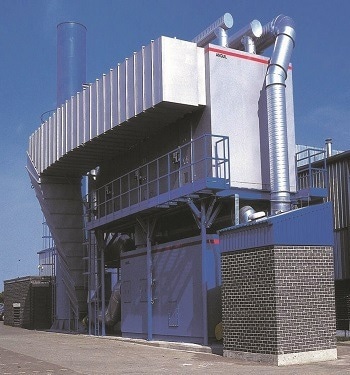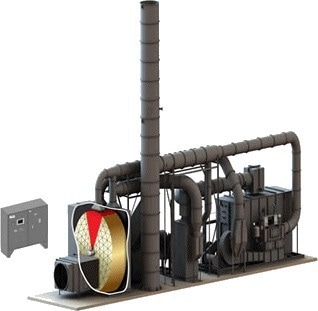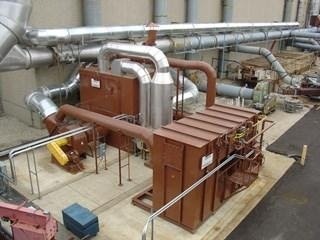An adsorption system called the Anguil Emission Concentrator was created to convert massive volumes of low-concentration process exhaust into a considerably smaller, more highly concentrated air stream.

Image Credit: Anguil Environmental Systems
The significantly reduced flow that contains a higher concentration of volatile organic compounds (VOCs) is sent to a thermal or catalytic oxidizer for VOC destruction. The destruction device’s size can be drastically reduced, lowering capital expenditure.
The smaller abatement equipment decreases auxiliary fuel usage due to the greater VOC concentration managed after.
Product Overview
Benefits of Anguil’s Emission Concentrators
- Largest flow capacity in the industry at over 120,000 SCFM (192,600 Nm3/hr) in a single rotor
- Reduces the size of the abatement equipment by 90–95% of its original volume, resulting in significant capital and operating cost and energy savings

Image Credit: Anguil Environmental Systems
- 99%+ Destruction Rate Efficiency (DRE), Regulatory Compliance Guaranteed
- Concentration ratios as high as 20:1
- Concentrator wheel, desorption air heat and oxidizer integrated as a single system, simplifying installation and control scheme
- Regenerative Thermal Oxidizers (RTOs), Thermal Recuperative Oxidizers, and Catalytic Recuperative Oxidizers can be supplied to treat the concentrated stream
- Numerous options for source of desorption air heat
- High-efficiency filter plenums
- Zeolite wheel options to prevent polymerization and minimize risk of fires
- Programmable Logic Controllers (PLCs): automates operation from start-up to shut down, reducing the need for operator interaction. The system’s operation can be monitored and changed over a modem through remote telemetry, cutting down on maintenance expenses and downtime. Available are control rooms and numerous enclosure options
Air Flow Range and Efficiency
Air Flow Range
- 5,000–120,000 SCFM (8,025–192,600 Nm3/hr) (Single Rotor)
Destruction & Removal Efficiency (DRE)
- 95–99% (Higher DRE can be reached with multiple rotors in series)
Ideal Applications
- Large Volume, Low Concentration
- Low relative humidity, 90% max RH
- Exhaust of 100 °F (38 °C) or less
Features
Anguil Emission Concentrator Features and Design Options
- Continuous adsorption of VOCs onto the rotor as opposed to a batch-type adsorption vessel
- Concentrator rotor, desorption air heat, and oxidizer integrated as a single system, simplifying installation and controls
- Over 120,000 SCFM (192,600 Nm3/hr) capacity with a single rotor system
- Robust Programmable Logic Controller (PLC) based controls with digital data recording, remote telemetry, and various configuration options
- Completely shop-assembled, pre-wired, and tested before shipment
- Zeolite adsorbent rotor minimizes risk of fires common to carbon systems with certain VOC/HAP emissions
- Low pressure drops, typically 3”–5” W.C.
- Removal efficiencies of 95–99%
- Concentration ratios as high as 25:1
Options
- Numerous options for desorption air heat
- Fully-integrated concentrator–oxidizer systems, including common controls stream
- Multiple rotors in series or parallel for even higher DRE or higher airflows
- Various zeolite substrate options to prevent polymerization
- High-efficiency filter plenums to protect the adsorbent from process particulate exhaust

Image Credit: Anguil Environmental Systems
Operating Cost Reduction Strategies
- Primary or secondary heat and Energy Recovery Solutions
- Oxidizer Service and Preventive Maintenance Evaluations (PME)
How Do Emission Concentrators Work?
The rotor concentrator, which removes VOC emissions from the air and adsorbs them onto the zeolite, processes the high-volume, low-concentration airstream. Most of this clean air—roughly 90–95% of the entire air volume—is subsequently vented to space.
About 5–10% of the entire air volume, or a tiny fraction of the air stream, is heated to a high temperature and used as desorption air.
Pollutants that have been adsorbed are moved into a desorption section by the concentrator rotor’s continual, extremely slow spinning. The low-volume heated airstream used in the desorption section desorbs or releases the VOCs from the adsorptive medium. An oxidizer processes this low-volume, high-VOC-containing air.
The concentrator with an integrated oxidizer is frequently the most economical technique for processing high-volume, low-concentration streams. The true benefits are obtained in lower operating expenses, even while a system's initial cost is competitive with other technologies.
A concentrator and an oxidizer operate with low or no natural gas usage. It has enough “free energy” at higher concentrations to power the concentrator's desorption process.